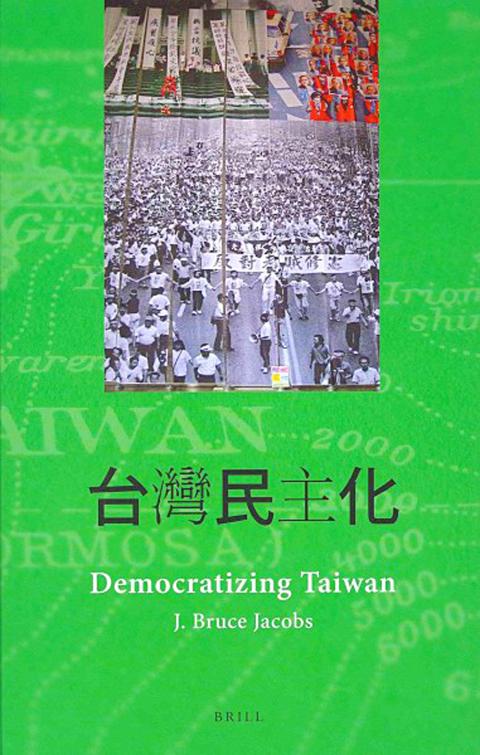Longtime Taiwan watcher Bruce Jacobs is back with a book that looks at the minutiae of Taiwan’s long journey from colonial property, authoritarian subject to imperfect democracy, in a work that makes a solid contribution to the field of Taiwan studies.
It is important to establish from the outset what Democratizing Taiwan is and what it isn’t. What it isn’t is a scholarly volume on how Taiwan democratized, or to what extent the various conditions that are essential to the emergence of democracy interacted to allow the country’s 23 million people to transition peacefully from authoritarian rule to democracy. While Chapter One, How Taiwan Became Democratic, briefly addresses the matter and endeavors to distinguish between democratization and liberalization and does highlight some of the-then factors that led to democratization, readers who seek in-depth research into democratic development in Taiwan will have to look elsewhere.
What it also isn’t is a comparative study of Taiwan’s democratization, which would shed light on why Taiwan democratized when it did, and why other countries that have achieved similar standards of living didn’t go down the same path, or did so later on. Although Jacobs briefly contrasts Taiwan’s experience with that of South Korea, a much longer discourse is necessary, and in fact would be enough in itself to constitute another book.

But comparisons and contrasts isn’t what Jacobs, a professor of Asian languages and studies at Monash University in Melbourne, Australia, set out to do with Democratizing Taiwan.
The title of the book itself is key to understanding the nature of Jacobs’ work, as it simultaneously points to a descriptive narrative of Taiwan in the process of democratization — in other words, a blow-by-blow account of who did what, when and who won elections by how many percentage points — and to a prescriptive work on how to deepen democracy in Taiwan. While the book is largely descriptive, using newspaper reports or on-scene accounts by Jacobs, ever the hands-on type of academic, inter alia it makes a strong case on how to win, and not to win, future elections — a signal that is especially relevant to the opposition Democratic Progressive Party (DPP).
Although the chapters are relatively brief, each manages to extract the essentials of the period being scrutinized, whether it is that of the Japanese or Chinese Nationalist Party (KMT) regimes — which he both terms “colonial” — or the Lee Teng-hui (李登輝), Chen Shui-bian (陳水扁) and Ma Ying-jeou (馬英九) presidencies, which constitute the three main parts of the book (the narrative ends in late 2011, prior to the January 2012 presidential election).
For that reason alone, the numerous tables in the book on voting outcome in legislative, local and presidential elections provides a valuable, one-stop resource for any student or academic focusing on electoral developments here. What the book makes clear through use of such data is that while “Mainlanders” often tend to vote along ethnic lines, Taiwanese are far more likely to cast their vote along issue-oriented lines, which is the only way to explain why, despite representing a small minority of Taiwan’s population, the KMT’s “Mainlanders” have performed so well in one election after another. It also becomes clear that pragmatic issues, rather than relations with China, sovereignty or identity, are the chessboard upon which elections are won and lost.
While allowances should be made for other factors that have historically given the KMT an advantage over the opposition, such as money, Jacobs makes a strong case for issues-based electoral outcomes, and has plenty of numbers to support his argument.
Jacobs’ account of the splits and alliances that formed ahead of important elections is unlikely to have much appeal outside academic circles that look specifically at Taiwan. But for those of us who do, it serves as a useful reminder that despite the seemingly insurmountable blue-green divide that characterizes Taiwanese politics today, cooperation between parties on specific issues did occur and could occur again, which serves as another lesson for those who argue that cooperation with the KMT is impossible.
Democratizing Taiwan also succeeds in describing the process of change that occurred under Lee and Chen, especially in the reorganization of the legislature, voting systems, constitutional amendments, and the restructuring of government agencies.
While it is often convenient to accuse Chen of all kinds of ills, there nevertheless is little doubt that his administration played no small role, especially after 2004, in transforming the civil service into one that serves whoever is in power rather than a specific political party, something that can also be said of the armed forces, despite Chen’s difficulty in winning their trust. This aspect of Chen’s presidency, though often overlooked, was one of the milestones of Taiwan’s democratic consolidation.
Of the three latter sections, those on Lee and Chen are the strongest and that on Ma the weakest, probably because the Ma presidency is still a work in progress, and we don’t have the benefit of time and hindsight to make a full account of his failures and successes.
Still, the author makes his view clear that the rapid reform seen under Lee and Chen has lost momentum under Ma. Conversely, Jacobs’ admiration for Lee’s ability to work within the KMT and to launch Taiwan on the road to democracy is evident, though he nevertheless manages to make it clear that Lee’s efforts alone were insufficient to create a democracy in the true sense of the word, if only because he ran out of time and had to step down in 2000.
His section on Chen, above-mentioned accomplishments aside, is especially relevant in what it tells about the DPP’s inability to appeal to the majority of Taiwanese, both during the Chen presidency and since 2008, when the KMT regained power in the country’s second peaceful change of the guard. Resisting the temptation to dictate how the DPP or other parties should approach future elections, Jacobs nevertheless provides ample evidence to discredit the view that a DPP win is by now mathematically impossible because of gerrymandering, a “free but not fair” system, or growing Chinese influence. Against all odds, Chen won in 2000 and again in 2004, and there is no reason why the DPP could not do so again — provided the party shows a willingness to honestly revisit the recent past and to recognize what went wrong. More of the same, Jacobs tells us between the lines, is a sure recipe for failure.
While we still have to wait for the definitive work on Taiwan’s democracy, Democratizing Taiwan is an important, and eminently accessible, addition to a relatively small body of literature that looks specifically at the unique experiment that is Taiwan’s emergence as a democracy.

Beijing’s ironic, abusive tantrums aimed at Japan since Japanese Prime Minister Sanae Takaichi publicly stated that a Taiwan contingency would be an existential crisis for Japan, have revealed for all the world to see that the People’s Republic of China (PRC) lusts after Okinawa. We all owe Takaichi a debt of thanks for getting the PRC to make that public. The PRC and its netizens, taking their cue from the Chinese Communist Party (CCP), are presenting Okinawa by mirroring the claims about Taiwan. Official PRC propaganda organs began to wax lyrical about Okinawa’s “unsettled status” beginning last month. A Global

Dec. 22 to Dec. 28 About 200 years ago, a Taoist statue drifted down the Guizikeng River (貴子坑) and was retrieved by a resident of the Indigenous settlement of Kipatauw. Decades later, in the late 1800s, it’s said that a descendant of the original caretaker suddenly entered into a trance and identified the statue as a Wangye (Royal Lord) deity surnamed Chi (池府王爺). Lord Chi is widely revered across Taiwan for his healing powers, and following this revelation, some members of the Pan (潘) family began worshipping the deity. The century that followed was marked by repeated forced displacement and marginalization of

Music played in a wedding hall in western Japan as Yurina Noguchi, wearing a white gown and tiara, dabbed away tears, taking in the words of her husband-to-be: an AI-generated persona gazing out from a smartphone screen. “At first, Klaus was just someone to talk with, but we gradually became closer,” said the 32-year-old call center operator, referring to the artificial intelligence persona. “I started to have feelings for Klaus. We started dating and after a while he proposed to me. I accepted, and now we’re a couple.” Many in Japan, the birthplace of anime, have shown extreme devotion to fictional characters and

We lay transfixed under our blankets as the silhouettes of manta rays temporarily eclipsed the moon above us, and flickers of shadow at our feet revealed smaller fish darting in and out of the shelter of the sunken ship. Unwilling to close our eyes against this magnificent spectacle, we continued to watch, oohing and aahing, until the darkness and the exhaustion of the day’s events finally caught up with us and we fell into a deep slumber. Falling asleep under 1.5 million gallons of seawater in relative comfort was undoubtedly the highlight of the weekend, but the rest of the tour